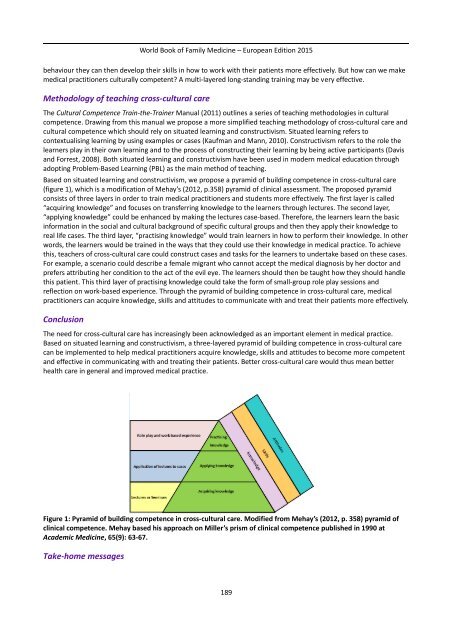Family Medicine
World Book 2015
World Book 2015
Create successful ePaper yourself
Turn your PDF publications into a flip-book with our unique Google optimized e-Paper software.
World Book of <strong>Family</strong> <strong>Medicine</strong> – European Edition 2015<br />
behaviour they can then develop their skills in how to work with their patients more effectively. But how can we make<br />
medical practitioners culturally competent? A multi-layered long-standing training may be very effective.<br />
Methodology of teaching cross-cultural care<br />
The Cultural Competence Train-the-Trainer Manual (2011) outlines a series of teaching methodologies in cultural<br />
competence. Drawing from this manual we propose a more simplified teaching methodology of cross-cultural care and<br />
cultural competence which should rely on situated learning and constructivism. Situated learning refers to<br />
contextualising learning by using examples or cases (Kaufman and Mann, 2010). Constructivism refers to the role the<br />
learners play in their own learning and to the process of constructing their learning by being active participants (Davis<br />
and Forrest, 2008). Both situated learning and constructivism have been used in modern medical education through<br />
adopting Problem-Based Learning (PBL) as the main method of teaching.<br />
Based on situated learning and constructivism, we propose a pyramid of building competence in cross-cultural care<br />
(figure 1), which is a modification of Mehay’s (2012, p.358) pyramid of clinical assessment. The proposed pyramid<br />
consists of three layers in order to train medical practitioners and students more effectively. The first layer is called<br />
“acquiring knowledge” and focuses on transferring knowledge to the learners through lectures. The second layer,<br />
“applying knowledge” could be enhanced by making the lectures case-based. Therefore, the learners learn the basic<br />
information in the social and cultural background of specific cultural groups and then they apply their knowledge to<br />
real life cases. The third layer, “practising knowledge” would train learners in how to perform their knowledge. In other<br />
words, the learners would be trained in the ways that they could use their knowledge in medical practice. To achieve<br />
this, teachers of cross-cultural care could construct cases and tasks for the learners to undertake based on these cases.<br />
For example, a scenario could describe a female migrant who cannot accept the medical diagnosis by her doctor and<br />
prefers attributing her condition to the act of the evil eye. The learners should then be taught how they should handle<br />
this patient. This third layer of practising knowledge could take the form of small-group role play sessions and<br />
reflection on work-based experience. Through the pyramid of building competence in cross-cultural care, medical<br />
practitioners can acquire knowledge, skills and attitudes to communicate with and treat their patients more effectively.<br />
Conclusion<br />
The need for cross-cultural care has increasingly been acknowledged as an important element in medical practice.<br />
Based on situated learning and constructivism, a three-layered pyramid of building competence in cross-cultural care<br />
can be implemented to help medical practitioners acquire knowledge, skills and attitudes to become more competent<br />
and effective in communicating with and treating their patients. Better cross-cultural care would thus mean better<br />
health care in general and improved medical practice.<br />
Figure 1: Pyramid of building competence in cross-cultural care. Modified from Mehay’s (2012, p. 358) pyramid of<br />
clinical competence. Mehay based his approach on Miller’s prism of clinical competence published in 1990 at<br />
Academic <strong>Medicine</strong>, 65(9): 63-67.<br />
Take-home messages<br />
189


